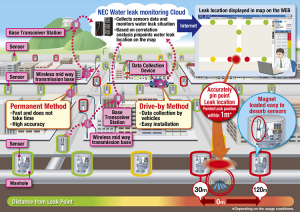In this project we’ll show you how to find the source of any water leaks around your house, going through all the different potential sources of water in your house to make your water leak detection an easy process. The visual signs of the water leak are great indicators for where the leak is, whether it’s water coming through walls or water in your basement, so we cover these too so that you can properly identify where your leak is coming from.
If ou would additional help and advice on finding and tracing leaks you can contact Property Repair Systems on 01626 336180 for additional free assistance.
Firstly Use a Damp Meter to Locate the Area Affected by the Water Leak
If you think that you may have a water leak based on the fact that you have some damp or cold areas on your wall, you should confirm that these areas are damp or cold – there are a number of tools available to help you with this, such as a surface thermometer or damp meter – these can also be useful if you’re not sure where all of the affected areas are. If you can’t get hold of one of these devices just use the back of your hand to detect colder or damper areas of your wall, floor or ceiling.
A damp meter does what it says on the tin – you stick its prongs into your wall and it tests the wall for dampness. You can also use a hygrometer – this tests the moisture content of the air in your room, and is useful for determining whether condensation is the real cause of your damp patches rather than a water leak behind or in your wall. More information on damp meters, surface thermometers and hygrometers and the ability to purchase them is available on PRS’s website – we have found this company to have a consistently high level of expertise in the field of damp issues.
Use a damp meter like this one to find the area of your wall or ceiling affected by the leak
A hygrometer measures the dampness of the air inside your house – a high reading may indicate that condensation is the issue rather than a water leak
Water Leak Detection Checklist
- The leak may be coming from your water mains supply, or there may be a mains water leak from your neighbour’s property. A leaking water main further up the road also could cause any leakage into your basement that you may be experiencing. You can contact your water supplier and get them to check your mains supply and your neighbours’ supply – the only neighbours that can really affect you are those either side of you or those on higher ground than you.
- If water has come through your walls or floor or into your basement you can get your water supplier to test it to determine where it’s come from – they will be able to tell you whether it’s ground water, mains water or sewage. You can find your local water supplier on Water UK’s website.
- You can test whether your foul water pipes have any leaks by blocking them up. Find out where your foul water drains away by turning a tap on and lifting up your manhole cover. You can block the hole the water flows from into the manhole with a bung available in either 4 inch or 6 inch sizes from your local builders’ merchants. Fill up your toilet bowl or sink with water and mark the level of the water. Leave the water overnight and see what happens – if the level of the water has dropped overnight then you need to get a drains company to come in to investigate and trace the leak in your pipes. You can find a qualified company to do this on the National Association of Drainage Contractors website. Alternatively, you may have a pretty good idea of where the leak is coming from at this point if you know where your wet area is, so you will know what needs to be mended. Make sure you remove the bung after completing the test!
- You can check whether the leak is coming from a fault in your surface drain by using a bag of drains testing dye that you can buy from your local builders’ merchants. Put the dye in the drain and then filling the drain up with water. This dye glows in the dark so you can then look at your leak at night and look for the dye to confirm that the water is coming from your surface drain.
- If the water is leaking in your bathroom or kitchen it’s a good idea to check your plumbed in appliances and bathtub/shower cubicle, sink and toilet.
- If the water is appearing in your floor you should check your central heating system as this may be the source of the leak – check your pipes and radiators, with your first check being the pipes that run under the area of damp floor. You can also ask a plumber in to do a pressure test as this may help to trace where in the system the leak is coming from if this is the source of the leak.
Check any water pipes in your floor for leaks, including underfloor heating
If you can’t find any leaks but you still have damp and cold patches of wall, these may be being caused by damp rather than a leak. Take a look at our Diagnosing Damp project to work out what kind of damp may be affecting your walls.
source:here

Comments
You may use these HTML tags and attributes: <a href="" title=""> <abbr title=""> <acronym title=""> <b> <blockquote cite=""> <cite> <code> <del datetime=""> <em> <i> <q cite=""> <s> <strike> <strong>

Be the first to comment.